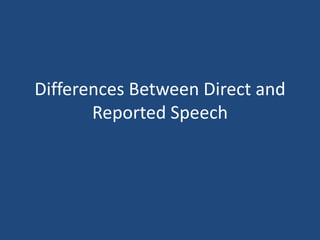Differencesbetweendirectandreportedspeech 120501154221-phpapp01
•Download as PPTX, PDF•
0 likes•948 views
Report
Share
Report
Share

More Related Content
What's hot
What's hot (20)
Viewers also liked
Viewers also liked (7)
Similar to Differencesbetweendirectandreportedspeech 120501154221-phpapp01
Similar to Differencesbetweendirectandreportedspeech 120501154221-phpapp01 (20)
program language and Languages focus Reported Speech

program language and Languages focus Reported Speech
More from Anne Agard
More from Anne Agard (20)
Recently uploaded
Recently uploaded (20)
WebRTC and SIP not just audio and video @ OpenSIPS 2024

WebRTC and SIP not just audio and video @ OpenSIPS 2024
Linux Foundation Edge _ Overview of FDO Software Components _ Randy at Intel.pdf

Linux Foundation Edge _ Overview of FDO Software Components _ Randy at Intel.pdf
JavaScript Usage Statistics 2024 - The Ultimate Guide

JavaScript Usage Statistics 2024 - The Ultimate Guide
Introduction to FIDO Authentication and Passkeys.pptx

Introduction to FIDO Authentication and Passkeys.pptx
Event-Driven Architecture Masterclass: Engineering a Robust, High-performance...

Event-Driven Architecture Masterclass: Engineering a Robust, High-performance...
State of the Smart Building Startup Landscape 2024!

State of the Smart Building Startup Landscape 2024!
Collecting & Temporal Analysis of Behavioral Web Data - Tales From The Inside

Collecting & Temporal Analysis of Behavioral Web Data - Tales From The Inside
Continuing Bonds Through AI: A Hermeneutic Reflection on Thanabots

Continuing Bonds Through AI: A Hermeneutic Reflection on Thanabots
Hyatt driving innovation and exceptional customer experiences with FIDO passw...

Hyatt driving innovation and exceptional customer experiences with FIDO passw...
The Zero-ETL Approach: Enhancing Data Agility and Insight

The Zero-ETL Approach: Enhancing Data Agility and Insight
Extensible Python: Robustness through Addition - PyCon 2024

Extensible Python: Robustness through Addition - PyCon 2024
Differencesbetweendirectandreportedspeech 120501154221-phpapp01
- 1. Differences Between Direct and Reported Speech
- 2. Simple Present Simple Past: He said, “I know you.” He said (that) he knew me.
- 3. Notice that the pronoun also changes (you me). He said, “I know you.” He said (that) he knew me.
- 4. Present Continuous Past Continuous He said, “I am studying.” He said (that) he was studying.
- 5. Past Continuous Past Perfect Continuous He said, “She was helping me.” He said (that) she had been helping him.
- 6. Notice that the pronoun also changes (me him). He said, “She was helping me.” He said (that) she had been helping him.
- 7. Present Perfect Past Perfect He said, “I have taken the test.” He said (that) he had taken the test.
- 8. Past Perfect Past Perfect (no change): He said, “I had never done that.” He said (that) he had never done that.
- 9. New problems with modals Can, May, Must and Will Change in Reported Speech:
- 10. Can Could He said, “I can help you tomorrow.” He said (that) he could help me the next day.
- 11. Notice the pronoun change (you me): He said, “I can help you tomorrow.” He said (that) he could help me the next day.
- 12. Also notice the change in time expressions (tomorrow the next day): He said, “I can help you tomorrow.” He said (that) he could help me the next day.
- 13. “May” has two meanings, possibility and permission. The change for reported speech is different for these two meanings!
- 14. May Might when the meaning is possibility: He said, “She may leave early.” He said (that) she might leave early.
- 15. May Could when the meaning is permission: He said, “You may go.” He said (that) I could go.
- 16. Notice the pronoun change (you I): He said, “You may go.” He said (that) I could go.
- 17. Must had to He said, “I must go.” He said (that) he had to go.
- 18. Will would He said, “I will go.” He said (that) he would go.
- 19. Some modals do not change in reported speech: Should, should have and must have:
- 20. Should should He said, “You should leave.” He said (that) I should leave.
- 21. Notice the pronoun change (you I): He said, “You should leave.” He said (that) I should leave.
- 22. Should have should have (reporting a mistake in the past): He said, “You should have told me.” He said (that) I should have told him.
- 23. Notice the pronoun changes: you I me him: He said, “You should have told me.” He said (that) I should have told him.
- 24. Must must have (meaning that something probably happened in the past): He said, “You must have known.” He said (that) I must have known.
- 25. Notice the pronoun change (you I): He said, “You must have known.” He said (that) I must have known.
